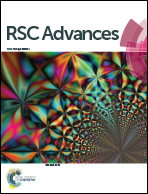Toughening of amorphous poly(propylene carbonate) by rubbery CO2-based polyurethane: transition from brittle to ductile†
Abstract
Amorphous poly(propylene carbonate) (PPC) is brittle at room temperature, but the studies related to the toughening of PPC is rare. Herein, two types of polyurethane (PCO2PU) synthesized from a CO2-based diol and toluene diisocyanate were used as rubbery particles to toughen PPC. The notched impact strength of PPC increased from 20.8 J m−1 to 54.2 J m−1 at a PCO2PU loading of 20 wt%, comparable with that of neat nylon 6, and reached 228.3 J m−1 at a PCO2PU loading of 30 wt%, 10.9 fold that of neat PPC and even higher than bisphenol A polycarbonate. Matrix yielding as well as cavitation was observed during the impact process, which was responsible for the increase of impact strength. Moreover, the toughening efficiency was related with the carbonate content of PCO2PU, and the transition of fracture behavior from brittle to ductile occurred when the PCO2PU with a weight average diameter of 0.20 μm was uniformly dispersed in PPC substrate.


 Please wait while we load your content...
Please wait while we load your content...